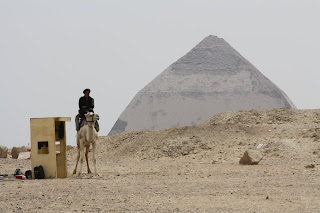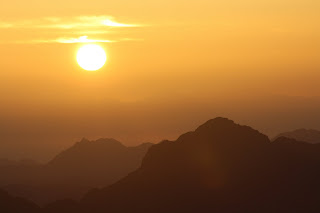Wandering Egypt, it seems there are two things you cannot escape: the sand and the baksheesh. The first is self-explanatory (Egypt is a desert) but the second part is a tradition of supplementing people’s income. In the United States they call baksheesh "tipping," but here it is a whole other ballgame. Someone might insist on carrying your bags to your room, and then expect baksheesh. Someone might point out that standing in front of a monument is a good place to take a picture, and then expect baksheesh. Someone might give you a small trinket, insisting, “free, free”, and then get upset when they do not get baksheesh. You have to learn to say “no thanks” to people who seem to be selflessly offering their assistance, rather forcefully insisting you carry your own bags, or refusing to dry your hands with the toilet paper being waved in your face, or otherwise be prepared to follow it up with a hand out.
Granted, not all who help are selfish. Several times we have had random people assist in translating our destination to a cab driver, or point us in the direction of our destination without seeking compensation. So, one learns to read people and their motivations, hoping for the best and having small change at the ready.

In an attempt to be un-touristy, we found this minaret. We figured since the old people have a photo of it framed somewhere, that would be okay.

Mosques are almost as common as churches in the United States, and far more noticeable because 5 times a day they remind Muslims that it is time to pray with a call to prayer.

Before prayer, Muslims must wash their bodies, particularly their hands and face. When they pray, they are always on a carpet or mat of some sort. Here you can see a man laying out the mats in anticipation of the evening prayer. But this is not only restricted to mosques, as people will stop and pray wherever they are. We've seen large groups of men praying at the train station in the evening on mats provided by the attendants there (men and women pray separately).

Sometimes called the "City of a Thousand Minarets," we'd like to propose an alternate name for Cairo: "City of a Million Satellite Dishes."

Sand dunes, they’re everywhere. Like this one…isn’t it cute?

But wait! Why are there stairs leading down under this sand dune? That’s not a sand dune. That’s a pyramid! Not exactly the most amazing structure, but down inside there is a sarcophagus, and all over the walls we saw hieroglyphics. This is probably what drives some archeologists insane, knowing that any sand dune might actually be a sand-covered pyramid. Granted, if you start looking too hard, everything starts to look like a pyramid. But nonetheless, we’re pretty sure there is a tiger somewhere in this photo.

There are also some more obvious pyramids, like this one at Abu Sir. Someone forgot to tell the architect these buildings are expected to hold up for 3000 years…

Further south of Cairo you find the oldest stone monument in the world, the Step Pyramid. While not considered the first pyramid because pyramids don’t have notches in the side, the Step Pyramid was the first structure that was created above the ground to hold a Pharaoh’s tomb, and was also the inspiration for the pyramids.

While people are no longer allowed to climb to the top of the pyramid, that didn’t stop Justin. Granted, when he uses his ray gun to make himself super big there’s not much anyone can do to stop him.

Tourist Lady: “Wow, this is just so amazing, there is just so much history here.”
Guide: “Yes, yes there is.”
Tourist Lady: “John, I just didn’t think pyramids looked like that, did you think they looked like that?”
John: “No, I –"
Tourist Lady: “Because that didn’t look like what I thought a pyramid looked like. It looked like a pile of rocks and sand. How do people find even them?”
Guide: “Pyramids are usually in groups, so they –“
Tourist Lady: "Really? I had no idea. There are so many things you just always have to look out for. Oh my goodness! What are those things over there? With the circles made of stone. Is that some kind of sacrificing table?”
Guide: “No, those are benches.”
Tourist Lady: “Really? Like where the Pharaoh sat to admire their pyramid?”
Guide: “No, like where tourists sit to catch their breath because they talk too much.”
(While some of this conversation was fictionalized for dramatic effect, some of the questions were not.)
This is the Bent Pyramid. Called that for obvious reasons, they apparently built it about half way up before it started to collapse in on itself, so the builders decided to decrease the angle of the slope from 51º to 43º, thus keeping it from completely collapsing.

Finally, the oldest true smooth-sided pyramid, the Red Pyramid. You can actually hike down into this pyramid, although if you like open spaces and the smell of fresh air, this hike may not be for you. It is also the third largest pyramid in Egypt. Now if Justin could just learn to smile on command, or if his beard would just cover up his mouth altogether, we’d be in business.
Next, Luxor, site of the infamous Valley of the Kings!






















































